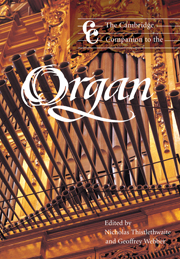Book contents
- Frontmatter
- Part I The instrument
- Part II The player
- Part III Selected repertoires
- 10 Italian organ music to Frescobaldi
- 11 Iberian organ music before 1700
- 12 The French classical organ school
- 13 English organ music to c1700
- 14 Catholic Germany and Austria 1648–c1800
- 15 The north German organ school
- 16 The organ music of J. S. Bach
- 17 German organ music after 1800
- 18 French and Belgian organ music after 1800
- 19 British organ music after 1800
- 20 North American organ music after 1800
- Appendix: The modes (toni) and their attributes according to Zarlino
- Notes
- Bibliography
- Index
20 - North American organ music after 1800
from Part III - Selected repertoires
Published online by Cambridge University Press: 28 September 2011
- Frontmatter
- Part I The instrument
- Part II The player
- Part III Selected repertoires
- 10 Italian organ music to Frescobaldi
- 11 Iberian organ music before 1700
- 12 The French classical organ school
- 13 English organ music to c1700
- 14 Catholic Germany and Austria 1648–c1800
- 15 The north German organ school
- 16 The organ music of J. S. Bach
- 17 German organ music after 1800
- 18 French and Belgian organ music after 1800
- 19 British organ music after 1800
- 20 North American organ music after 1800
- Appendix: The modes (toni) and their attributes according to Zarlino
- Notes
- Bibliography
- Index
Summary
The early nineteenth century
In her major study of American organ building, Orpha Ochse notes that ‘the early nineteenth-century American organ was an instrument without a repertoire’ (Ochse 1975: 111ff.). Although various method books included examples of original organ compositions, improvisation was a mainstay of church organists well into the nineteenth century. Nineteenth-century organ builders inherited traditions of eighteenthcentury organ building in the English and German styles. David Tannenberg's last organ, built in 1804 for Christ Lutheran Church, York, Pennsylvania, shows his German heritage (Armstrong 1967: 110). An early three-manual instrument by William Goodrich of Boston for the First Presbyterian Church, New Orleans, Louisiana (1815–20) shows English influence (Owen 1979: 425):
Great: 8.8.4.2⅔.2.III (bass).IV (treble)
Swell: 8.8.4.8.8
Choir: 8.8.4.8
The roots of eclecticism, the juxtaposition and reconciliation of diverse elements, run deep in American society. The mixture of various national traditions, fascination with technical complexity, innovation and experimentation (‘tinkering’) were natural parts of an organ culture separated from the regional traditions of Europe. For example, William Goodrich owned a copy of Dom Bédos's L'Art du Facteur d'Orgues. With regard to organ building traditions in New England, Owen points out that ‘the teachers were American and the subject matter was English, but the textbook was French’ (Owen 1979: 45).
By mid-century, American-born musicians had written and published a repertoire of literature and instruction books (Owen 1979: 109ff.; Owen 1975–91). American Church Organ Voluntaries, published in 1856 by A. N. Johnson, was the first anthology of organ music compiled and published by an American-born composer.
- Type
- Chapter
- Information
- The Cambridge Companion to the Organ , pp. 299 - 315Publisher: Cambridge University PressPrint publication year: 1999
- 1
- Cited by



